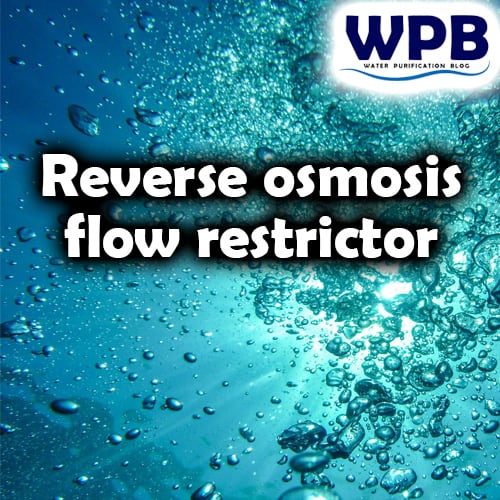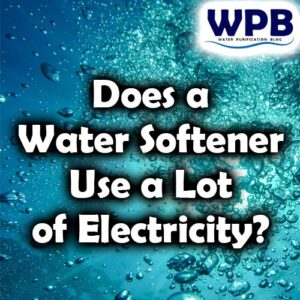Reverse osmosis (RO) is a water purification process that uses a semipermeable membrane to remove dissolved minerals and produce high quality water. It is used for industrial applications, but also for drinking water treatment.

in many forms and flow ratings
The reverse osmosis process works by forcing feedwater containing dissolved impurities such as salts and minerals through a semipermeable membrane by high pressure into two separate streams: one of removed solids, called concentrate or reject, and one of purified water, called the permeate.
Table of Contents
In order to achieve optimal water quality through the RO process, it is important to understand the role of a flow restrictor and it’s role in an RO system.
What is a Flow Restrictor in Reverse Osmosis?
As the RO membrane has it’s ideal conditions so it produces permeate efficiently, and wastes only the optimal amount of inlet water to drain, the flow restrictor is the main key to this.
A flow restrictor is a device that restricts the amount of concentrate – the water flowing through the RO system to the drain.
This helps to ensure that the system does not produce more waste water than needed, and maintains the required working pressure of the membrane.
It is equally important in domestic or industrial reverse osmosis systems.
Why is a Flow Restrictor Important in Reverse Osmosis?
Flow restrictors are very important in reverse osmosis systems for several reasons.
They maintain the right pressure of water that flows into a membrane, which is critical for efficient and effective removal of impurities.
They also help to ensure that the system does not produce more waste water than necessary, which reduces the overall cost of water production.
Furthermore, using the right flow restrictor rating ensures that the RO membrane does not become damaged due to overpressure.
How to Choose the Right Reverse Osmosis Flow Restrictor for Your System?
Choosing the right flow restrictor for your reverse osmosis system is important to ensure optimal water quality.
As a rule of thumb, the flow restrictor rating should be 4 times the RO membrane rating. This number resembles the water flow through the flow restrictor.
Benefits of Using a Flow Restrictor in Reverse Osmosis
Using a flow restrictor in reverse osmosis systems offers several benefits. Firstly, it ensures optimal water quality by maintaining the right pressure inside the system, on the RO membrane.
This helps to prevent damage to the RO membrane due to overpressure, and ensures that impurities are effectively removed from the water.
Secondly, it reduces the amount of waste water produced by the system, which reduces the overall cost of water production.
Finally, using the right flow restrictor rating ensures that the RO system operates efficiently, prolonging the lifespan of the system and reducing maintenance costs.
Where is the Flow Restrictor Located on Your RO System?
The flow restrictor can usually be found under the RO membrane housing.
It is always on the concentrate part of the piping that is going out of the membrane housing and is connected to the drain.
Additional Concentrate Rinsing
As the reverse osmosis system is operating, it is concentrating the dissolved salts and minerals in the concentrate part of the water. That is why the name of this water is concentrate.
The concentrated part of the water can make scale deposits on the membrane and therefore shorten it’s operating life cycle.
On more advanced reverse osmosis systems an electromagnetic valve can be found on the concentrate line, connected parallel with the flow restrictor.
This valve ensures that the concentrated salts are flushed out before starting and finishing water production. This can greatly improve RO membrane operating life cycle.
During starting and stopping of the system, this valve opens and the concentrate flow is much higher, which causes a higher flow through the membrane.
This helps to keep the membrane free form deposits forming.
Conclusion
Reverse osmosis flow restrictors play a critical role in ensuring optimal water quality in RO systems. Choosing the right flow restrictor rating is essential for maintaining the right pressure inside the system, reducing waste water production, and preventing damage to the RO membrane.
By understanding the importance of flow restrictors and their rating in RO systems, you can ensure that your system operates efficiently and produces high-quality, purified water.

Who am I?
I am working as a water treatment technical manager and I have more than 25 years of practical experience in water purification.
Water purification expert
After many years of experience in water purification, I want to share some of my knowledge and get people to know the real importance of water quality.
Water purification and water treatment are very complex themes, so it is important to explain them in an easy-to-read way.
On this blog, you will find many understandable, easy-to-read information about water purification.
I hope you enjoy it, find some useful information, and thank You for reading.
More info on my work and my expertise on water purification can be found on my LinkedIn profile.






